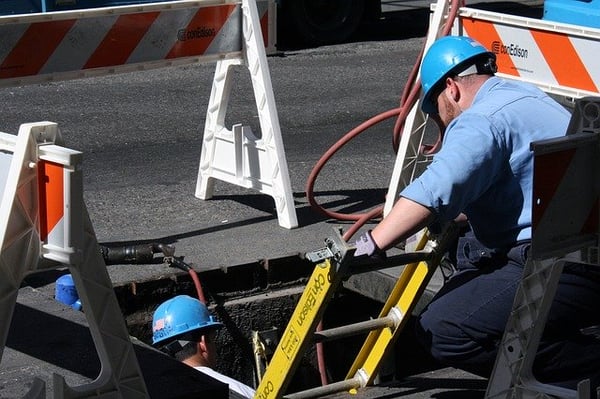 When most people hear “ergonomics,” they picture office workers at desks. But ergonomics – designing or modifying the working environment for the worker’s health and comfort – is just as important in the construction industry.
When most people hear “ergonomics,” they picture office workers at desks. But ergonomics – designing or modifying the working environment for the worker’s health and comfort – is just as important in the construction industry.
The challenge with ergonomic injuries is that they often go unnoticed until they become debilitating. According to the Occupational Safety and Health Administration (OSHA), 40% of construction workers say “working hurt” is a major problem. Many workers strain and hurt themselves in ways that are not obvious or catastrophic, but might not say anything to a supervisor until the pain is unbearable.
The good news is that strong ergonomic safety practices can reduce work-related musculoskeletal disorders. But you can’t practice “good ergonomics” without first identifying every potential ergonomic hazard in construction sites your company works at.
6 Ergonomic Hazards in Construction Worksites
Because of the physicality of the work, construction ergonomics present different challenges than the standard 9-5 desk job.
The most common roadblocks to safety are:
- Heavy lifting hazards
- Awkward grips and postures risks
- Repetitive tasks injuries
- Wrong tools, wrong result
- Poorly maintained tools
- Hard surfaces strain
1. Heavy Lifting Hazards
Many construction tools and materials are a challenge to lift -- weaklings need not apply. Just about everything on site seems to be heavy. Lifting 50-plus lbs. is hard on the body over time – especially if you’re doing it wrong.
Heavy lids and other hinged equipment have been the source of not only sore backs, but broken fingers and concussions as well. Many companies use counterbalanced and motion-controlled lids and doors on their equipment. These technologies can reduce the weight of lids and other hinged devices from 100 lbs. to 10 lbs. -- or less.
There are other tools and devices that minimize construction hazards, from basic levers to more advanced tools like ergonomic pallet lifts and impact guns.
The occasional use of heavy force or exertion is unavoidable. It goes without saying, but all construction workers absolutely need training on proper lifting techniques.
2. Awkward Grips & Postures Risk
Lifting an awkwardly shaped or positioned object turns a worker’s back into a ticking time bomb.
Trying to hold onto tools or other objects with awkward grips is not only exhausting but also can lead to hand and joint injuries. And contorting your body awkwardly to reach something or apply force is a recipe for various injuries.
Workers should use tools that allow them to hold their wrists straight. Jigs and tooling fixtures are a must for minimizing awkward posture.
3. Repetitive Tasks
Construction and industrial workers often have to perform the same lift over and over … and over.
When you have to perform a task hundreds or thousands of times, it can cause excessive wear and tear on your joints. It sounds silly, but even the most basic movements, like unpacking fasteners every day, can cause repetitive stress injuries.
Construction work is especially hand-intensive. The human hand is an impressive piece of engineering, but all those little muscles, tendons, ligaments, bones, and joints can only hold up to so much repetitive use. Your crew should take advantage of grips and gloves whenever possible to protect their hands during intensive work.
4. Wrong Tools; Wrong Training
Improvising with the wrong tool might get the job done, but it often comes at the expense of safety. Using equipment that isn’t designed for the task forces workers into awkward grips, unstable postures, and unnecessary strain. Over time, these small adjustments can create lasting injuries.
Having the right tool available is only part of the solution. Training workers on how to use that tool correctly helps them work efficiently without putting extra stress on their bodies. Clear guidance prevents mistakes that lead to pain and downtime.
5. Using Poorly Maintained Tools
When tools aren’t cared for, they start to work against the people using them. A stiff hinge or dull blade may not look serious, but it forces extra effort and awkward movements that wear on muscles and joints.
These small breakdowns add up. Workers often adapt without realizing the strain they’re putting on their bodies, and the result can be long-term injuries that are entirely preventable.
A consistent maintenance routine keeps tools operating the way they should. Regular checks make the job easier, safer, and less likely to cause harm over time.
6. Hard Surfaces
Spending long hours kneeling on concrete or other unforgiving surfaces takes a serious toll on joints. The impact builds gradually, leaving workers with lasting pain in their knees and backs.
Protective gear like kneepads can ease some of the strain, but the better solution is to limit how often crews have to work at floor level in the first place. Adjusting the height of a task with an ergonomic power lift or work table reduces stress on the body and helps workers stay healthier over time.
FAQs on Ergonomic Hazards in ConstructionHere are a few common questions about ergonomic hazards in construction that you may still be wondering after reading: Q: What are the long-term costs of ergonomic injuries for construction companies?A: Ergonomic injuries may start small, but they can lead to time off and long-term health issues that pull skilled workers from the job. This slows progress and creates gaps on crews that are difficult to fill quickly. The financial side is just as consequential. Companies face higher medical claims, workers’ compensation costs, and rising insurance premiums. Add in the expense of training replacements and the loss of experienced labor, and the impact on the bottom line becomes clear. Q: What specific ergonomic safety practices should be part of daily routines on site?A: Simple, consistent habits make a big difference. Daily stretches, safe lifting techniques, and short breaks throughout the day help reduce strain and fatigue. It’s also important to position tools and materials in ways that minimize twisting or reaching. Keeping equipment in good condition and inspecting it before each shift adds another layer of protection. These steps may seem small, but building them into the routine creates safer worksites and helps workers avoid injuries that build up over time. Q: How can construction managers spot early signs of ergonomic injuries before they become serious?A: Early warning signs are often subtle – workers shifting awkwardly, wincing during tasks, or rubbing sore joints. These behaviors usually appear before injuries are reported. Managers who encourage open communication can catch issues earlier. When workers know they won’t be judged for speaking up, they’re more likely to share discomfort. Addressing these signals right away – by rotating tasks, adjusting equipment, or offering medical checks – prevents small problems from turning into serious injuries. |
Better Ergonomics, Safer Construction Worksites
Construction is demanding work, and the strain doesn’t always show right away. That’s why paying attention to ergonomics matters – it’s about protecting people before the aches and injuries take hold.
Creating safer habits and choosing tools that ease the load show workers their well-being is valued. In turn, projects move forward with less disruption, and teams are able to give their best without sacrificing their health. A safe, productive job site starts with making ergonomics part of the everyday routine.
Need a Better Ergonomic Solution?
Have a question about tools, safety, or design? Our engineers are here to help.
(Editors Note: This article was originally published in January 2020 and was updated in October 2025 to reflect updated information)
.png?width=12000&height=2033&name=WeberKnappLogo_white%20(1).png)




